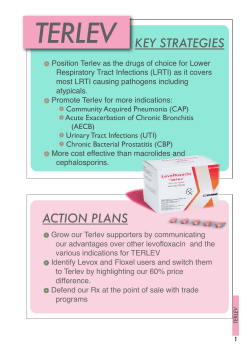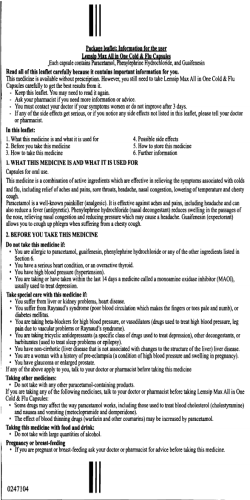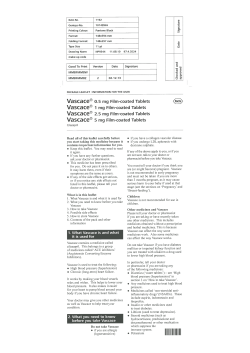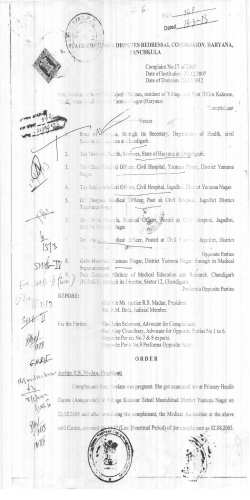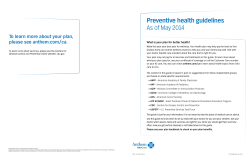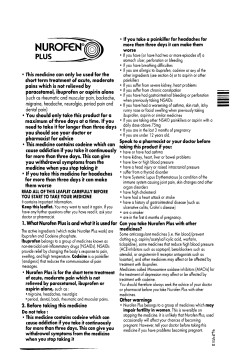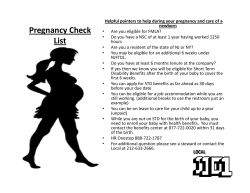
Leveraging Lab Information in New Ways to Benefit Healthcare
Leveraging Lab Information in New Ways to Benefit Healthcare in a Non-Fee-for-Service Environment Brad Brimhall, MD, MPH Professor, Pathology and Medicine & Medical Director, Clinical Laboratories University of Mississippi Health Care Curt Johnson Chief Operating Officer Orchard Software Opportunities for Laboratories to Provide Value in a Non-FFS Environment Current State of Healthcare • Transition away from FFS towards value-based payment models – Bundled Payments – Capitation – ACO Environments Page 3 The Laboratory’s New Role • Laboratories become more important, not less. • Adapt to changes in order to thrive. • Think of the laboratory’s overall impact on the organization, not as a silo within. • Business Analytics Page 4 Time of Transition = “Choppy Water” • Shore up the lab’s foundation. • Make sure your lab is prepared for the current & future environment. • Look for opportunities to improve patient outcomes. • Make the changes necessary to get there. Page 5 Target Area 1 1. “Right-size” Testing – Reduce waste (duplicate tests). – Reduce unnecessary testing/Recommend testing cascades. – Seek opportunities to improve (new equipment justification). Page 6 Target Area 2 2. Integrate & Collaborate – Radiology – Adult ICU – Pharmacy – Finance/Administration Page 7 Target Area 3 3. Identify areas where the lab can save healthcare dollars across the entire patient care episode. – Integrated Medical Analytics • Enterprise Data Warehouse Page 8 Target Area 4 4. Where does the reference laboratory fit in the new healthcare model? Page 9 “RIGHT-SIZE” TESTING Reduce Duplicate Testing Reduce Unnecessary Testing Quantify When Possible: Duplicate Testing • Launched an new enterprise HIS almost 2 years ago • Worked with the CMIO to implement alerts (aka best practice advisories) for duplicate laboratory testing • Need to follow financial impact as we implement new alerts (>8 mo) Executive War College April 30, 2014 Page 11 Started with BMP & CBC Using 4 Hr Duplicate Window Duplicate Testing Alerts Annualized Totals Test BMP CBC CBC W/ AUTO DIFF TOTAL Pct Total Canceled Canceled Vbl Cost 9,391 3,855 41.0% $45,255 4,461 1,669 37.4% $6,960 Total $94,635 $25,686 4,113 17,965 $26,354 $146,675 1,712 7,236 41.6% 40.3% $7,141 $59,356 Information updated periodically and provided to CMIO to use in meetings with CIO and executive leadership More Data Sources: Unnecessary Testing • “Money is tight” in healthcare these days • How can the laboratory can help with these challenges? • Potentially a great deal of unnecessary testing done in delivery networks. Page 14 Unnecessary Testing Groups Thyroid testing Example: FT4 ordered with TSH (should reflex FT4 from abnormal TSH) Liver Function Example: GGT ordered with ALKP (should reflex GGT from abnormal ALKP) Pancreatitis Example: AMY ordered with LIPA (LIPA has greater dx accuracy) Vitamin D testing Example: 1,25D ordered with 25D (should reflex 1,25 or order only in pts with renal failure) Unnecessary Testing Groups 2 Iron Status Example: FESAT ordered with FERR (should order one or the other; FESAT for iron overload or FERR for iron deficiency) General Inflammation Example: ESR ordered with CRP (CRP has greater dx accuracy) Myocardial Injury/Infarction Example: CKMB ordered with TROPI (TROPI has greater dx accuracy) Other Examples: VMA ordered in pt >20 year old (used primarily to dx tumor of children); MMA ordered with B12 (should reflex from abnormal B12) Systems Evaluated (Min 2 year period, 2008-2013) Hospital System: 4 hospitals (including rural) >500 providers Hospital System 2: >12 hospitals (including rural) >4,000 providers >10 small to medium hospital clients 4 Regional payers: US: 2 Northeastern, 1 Southeastern, 1 Western >6,000,000 covered lives Summary: Cost to Hospital System 1 Testing Group Volume Vbl Cost Total 14,668 $169,834 $302,769 Liver function 1,154 $9,947 $18,072 Pancreatitis 2,801 $24,341 $42,967 884 $43,732 $60,298 2,364 $31,536 $55,767 13,450 $83,794 $156,020 Myocardial injury/infarction 332 $7,944 $10,953 Other 454 $25,721 $34,491 36,107 $396,847 $681,336 Thyroid Vitamin D Iron status General inflammation Total (Annual) Summary: Cost to Hospital System 2 Stratified Cost Testing Group Volume Vbl Thyroid 94,841 $202,359 Liver function 16,388 Pancreatitis 20,378 Vitamin D Iron status General inflammation Myocardial injury/infarction Other Total (Annual) + Labor All Lab Total Cost $351,569 $475,555 $611,089 $23,763 $49,574 $71,042 $91,289 $35,662 $67,757 $94,452 $121,371 3,726 $128,547 $131,286 $131,286 $168,702 19,428 $68,581 $88,980 $114,231 $147,044 17,658 $13,773 $87,937 $111,069 $142,723 62,745 $274,823 $373,646 $455,842 $585,758 $50,887 $50,887 $65,390 3,338 $48,434 238,502 $750,940 $1,201,636 $1,504,564 $1,933,365 Summary: Paid-Out Payer Claims Annual Volume Total Paid Claims 536,097 $12,252,830 30,963 $458,420 172,798 $3,606,089 Vitamin D 33,864 $2,166,743 Iron status 145,186 $4,503,433 General inflammation 196,372 $1,868,772 Myocardial injury/infarction 146,537 $5,640,741 Other 53,643 $1,694,711 Total 1,315,460 $32,191,739 Testing Group Thyroid Liver function Pancreatitis Savings would amount to $0.39 PMPM for health plan members Policy Coverage Determinations New Equipment Justification The Broader View: New Equipment Proposal • Conference presentations: MALDI-TOF bacterial identification can save money for hospitals. • But….administrators are not convinced given the cost of the equipment. Page 23 Current Approach Fast, inexpensive, limited Slow, expensive, accurate A Tale of Two Projects I MALDI-TOF / Vitek profitability analysis Year Item Cost of Instrument Service contract Investment 1 2 3 4 5 Total ($312,387) $0 $0 $0 $0 ($19,178) $0 ($19,178) $0 ($19,178) $0 ($19,178) ($312,387) ($76,710) $0 $33,408 $33,408 $33,408 $33,408 $33,408 $167,040 Sum of cash flows ($312,387) $33,408 $14,230 $14,230 $14,230 $14,230 ($222,058) PV Cash Flows ($312,387) $33,408 $13,553 $12,907 $12,293 $11,707 ($228,519) $36,162 $14,382 $13,429 $12,539 $11,707 $88,219 Cost savings from reagents FV Reinvested +ve Cash Flows Payback period Payback period (years) Payback period (months) Payback period (weeks) Net present value Discount rate Project NPV 20.60 247.25 1,071.43 5% ($228,519) Modified internal rate of return Discount rate 5% Reinvestment rate 2% MIRR -22.34% Improved Diagnostic Efficiency Reduced Time to Bacterial Identification: Mean reduction = “34.3 hours” Lagace-Wiens PRS, Adam HJ, Karlowski JA, et al. J Clin Microbiol 2012;50:3324-3328 [University of Manitoba, Winnipeg, MB] Mean reduction = “1.45 days” (34.8 hours) Tan KE, Ellis B, Lee R, et al. J Clin Microbiol 2012;50:3301-3308 [Johns Hopkins University, Baltimore, MD] Mean reduction = “28.8 hours” Vlek ALM, Bonten MJM, Boel CHE. PLoS ONE 2012;7:e32589 [Univ. Medical Center, Utrecht, NL] Implications for Patient Care: Reduced time to appropriate therapy: 28.8% of patients (treating physician), 44.6% of patients (stewardship team) Tamma PD, Tan K, Nussenblatt VR, et al. Infect Control Hosp Epidemiol 2013;34:990-995 [Johns Hopkins University, Baltimore, MD] Increase in proportion of patients receiving appropriate treatment at 24 hours: 11.3% Vlek ALM, Bonten MJM, Boel CHE. PLoS ONE 2012;7:e32589 [Univ. Medical Center, Utrecht, NL] Percent with modification of empirical therapy: 35.1% Clerc O, Prod’hom G, Vogne C, et al. Clin Infect Dis 2013;56:1101-1107 [Univ. of Lausanne, Lausanne, CH] Finance/Accounting Data A Tale of Two Projects II MALDI-TOF / Vitek profitability analysis Year Item Investment Cost of Instrument Service contract 1 2 3 4 5 Total ($312,387) $0 $0 $0 $0 ($19,178) $0 ($19,178) $0 ($19,178) $0 ($19,178) ($312,387) ($76,710) Cost savings from reagents $0 $33,408 $33,408 $33,408 $33,408 $33,408 $167,040 *Cost savings from early d/c $0 $1,253,967 $1,253,967 $1,253,967 $1,253,967 $1,253,967 $6,269,836 Sum of cash flows ($312,387) $1,287,375 $1,268,198 $1,268,198 $1,268,198 $1,268,198 $6,047,778 PV Cash Flows ($312,387) $1,287,375 $1,207,807 $1,150,293 $1,095,517 $1,043,349 $5,471,954 $1,393,496 $1,281,735 $1,196,764 $1,117,427 $1,043,349 $6,032,772 FV Reinvested +ve Cash Flows Payback period Payback period (years) Payback period (months) Payback period (weeks) Net present value Discount rate Project NPV 0.24 2.91 12.62 5% $5,471,954 Modified internal rate of return Discount rate 5% Reinvestment rate 2% MIRR 80.79% Project Payback Period (y) MALDI-TOF Sensitivity Analysis 3.59 hours to get payback of 2 years Decrease in Mean LOS (h) Collaborative Projects with Clinical Colleagues Integrate & Collaborate RADIOLOGY Integrate & Collaborate: Radiology • Patients requiring contrast studies • “We will continue to lose patients as this type of poor service is happening in every area currently performing CT and MRI.” Director, Dx Radiology • Project reluctantly approved by administrators at the time • Evaluate actual impact of project Page 33 Outpatient Contrast Studies Data from Multiple Sources Combined Data Before/After Comparison POCT Launch 6/17/13 Before: 12/1/12-5/31/13 After: 7/1/13-12/31/13 Outpatient Contrast Studies HCPCS 71260 71270 71275 Description CT THORAX W/DYE CT THORAX W/O W/DYE CT ANGIOGRAPHY, CHEST Pre Vol 1852 15 506 Post Revenue Vol Pre Rev Post Rev Vol Diff Diff 1898 $554,324 $567,885 46 $13,561 29 $3,403 $8,388 14 $4,985 465 $143,580 $133,743 -41 ($9,837) ••••••••••••••••••••••••• 72156 72157 72158 MRI NECK SPINE W/O W/DYE MRI CHEST SPINE W/O W/DYE MRI LUMBAR SPINE W/O W/DYE TUMOR IMAGE PET/CT FULL BODY 78816 Total Annualized Annualized net revenue: Less cost of contrast, etc.: Less cost of POCT reagents: Net contribution to fixed costs: Profitability Cost of instruments: Payback (days): 186 223 $117,406 $140,761 37 $23,355 139 160 $93,904 $108,091 21 $14,187 232 295 $129,419 $164,563 63 $35,144 44 64 $23,104 $35,702 7968 8421 $3,443,293 $3,690,955 $495,323 15936 16842 $6,886,587 $7,381,910 20 453 906 $12,598 $247,662 $495,323 $32,767 $85,547 $377,100 $23,970 22.1 d Outpatient Contrast Studies Bottom Line: We started in June, 2013, and paid for all the instruments by the middle of July, 2013. From August, 2013, onward we are providing more than $375,000 per annum, “cash in the door” net of any additional costs, to the hospital Quality Improvement from the Project • Decreased wait times for patients: “…cut down on our wait time to almost no wait for labs on ER and outpatients.” [Chief MRI Technologist] • Fewer canceled studies after patient arrival (Pre = 17.7/month, post = 2.6/month) Page 39 Integrate & Collaborate Intensive Care Unit Integrate & Collaborate: Adult ICU • The hospital system recently began to assess physician and service productivity. • Colleagues who cover the adult ICU are concerned about how they might “measure up” and wanted baseline information for ICU-specific LOS and resource utilization. Page 41 ICU Productivity Metric Baseline Attending Patients Total LOS ICU LOS ICU Pct Vbl Cost Total Cost DOCTOR A 91 930 615 66.1% $1,513,787 $2,071,091 DOCTOR B 70 751 475 63.2% $1,431,864 $1,943,763 DOCTOR C 38 549 406 74.0% $992,608 $1,358,411 DOCTOR D 75 608 357 58.7% $809,222 $1,122,227 DOCTOR E 81 852 542 63.6% $1,147,182 $1,581,568 DOCTOR F 39 341 224 65.7% $525,479 $722,852 394 4031 2619 65.0% $6,420,141 $8,799,913 TOTAL Per Patient Day Per Patient Attending DOCTOR A DOCTOR B DOCTOR C DOCTOR D DOCTOR E DOCTOR F TOTAL Vbl Cost Total $16,635 $20,455 $26,121 $10,790 $14,163 $13,474 $16,295 Cost $22,759 $27,768 $35,748 $14,963 $19,526 $18,535 $22,335 Attending DOCTOR A DOCTOR B DOCTOR C DOCTOR D DOCTOR E DOCTOR F TOTAL Vbl Cost Total Cost $2,461 $3,368 $3,014 $4,092 $2,445 $3,346 $2,267 $3,143 $2,117 $2,918 $2,346 $3,227 $2,451 $3,360 Mean Lab Tests/ICU Patient Day ICU Productivity Lab Tests/ICU Day Physician Mean APR-DRG SI Weight Mean APDRG Weight Adjusts for case mix & severity of disease Physician Email from Director of ICU Medicine “This is really exciting. Is ICU LOS defined by service, provider, location, or per diem charge? If it is by per diem, then we also need to get it by service. This could get us the cost of staying in the ICU extra days without needing critical care services. The next step is to add it by a diagnosis. DKA is pretty clean and a good one to start with. Then if we can find a way to link ICU cost with severity of illness scores we may blow the roof off—very publishable and groundwork for really big things. This is really exciting. Lets discuss as soon as we get back. Thanks so much. This is getting me fired up again. Andy” [3/8/14] Page 45 Email from Medical Chief of Staff “Just now thinning down my pile of “to do” stuff; sorry it has taken a few days to get back with you. Needless to say, I was very impressed with what [the lab] has been able to accomplish as it relates to data analytics, especially since the message I’ve been receiving is that we can’t do anything like this because the data is a mess. …Let me continue to work on some questions/ICD-9/DRG stuff so we can start looking at something in addition to what you’re already doing. The CAG members will be helpful in this regard as well. This is incredibly exciting, especially if it works!! Peter” [2/3/14] Page 46 Integrate & Collaborate PHARMACY Integrate & Collaborate: Pharmacy • Colleagues in pharmacy estimate that we spend $12-15 million annually for unnecessary drugs • Asked to focus on antibiotic stewardship projects (and laboratory can help) • Start with selected expensive antibiotics (“gorillacillins”) Page 48 Expensive “Gorillacillin” Use Linezolid 600 mg PO Vancomycin 1000 mg IV Daptomycin 500 mg IV Expensive “Gorillacillin” Use Culture Sensitivity Report: “Sensitive to Vancomycin” 30 days Administration of Expensive Antibiotic Expensive “Gorillacillin” Use Drug DAPTOMYCIN 500 MG IV SOLN LINEZOLID 600 MG PO TABS Vanc Sens Doses Total Vbl Total Sensitive 1,014 $243,661 $310,076 Sensitive 280 $57,601 $73,302 1,294 $301,262 $383,378 Less Cost of Vanc $20,454 $26,028 NET COST SAVINGS $280,808 $357,350 $5,090 $6,477 TOTAL Plus another interesting finding… VANCOMYCIN HCL 1000 Resistant MG IV SOLN 322 Integrated Medical Analytics: Enterprise Data Warehouse Get Involved: New Enterprise DW Project • New Associate Vice-Chancellor for Research must develop a research data warehouse. • He needs additional support to design and launch the warehouse • We in the laboratory are invited to take a leading role: “The laboratory produces more ‘minable’ data than any other area in the hospital” Chief of Medical Staff Page 53 Data Model: Laboratory & Finance Presented internally at Grand Rounds Presented at national meetings with authors from: Department of Pathology Division of Finance Decision Support (Department of Finance) The Data Flow “BI/MI” Dashboard s Accounting & Finance Big Data Laboratory, Operational & Clinical ETL OLAP RDBMS Other (ad hoc) CDSS Reports The “Integrated Analytics Portfolio” CU Laboratory Data Warehouse (1998-Present) Laboratory Test Data Middleware HTML Operational & Medical Report Data Warehouse Hospital Administrative Data Direct SQL Query Document Statistical Analysis Research & Trend Analysis Reports CU Laboratory Data Warehouse Financial Measures from Projects Requiring DB Realized Cost Savings (2005) Annual savings Pct of total laboratory costs $746,200 4.5% Profitability (actual figures 1998-2005) Payback period 1.47 y NPV $2,968,639 MIRR 59.4% Still being used today! Future Outlook: Where do Reference Labs Fit? Partner with Customers: Reference Labs • Reference laboratories will face different challenges in the new information marketplace • What is critical for reference labs to succeed in the new healthcare models? – Provide analytics as well as results. Page 60 Customer Perspective • Visits to prospective and current client hospitals (35-140 beds) • Spoke with hospital executives and laboratory leaders • Asked about value of laboratory utilization reports • Several new clients acquired • Small point of difference vis-à-vis competitors 61 Hospital Executives “I see the great potential for not only rural facilities, but all of Banner in developing evidence-based protocols that could be shared across the industry.” Mike Gillen Former CEO, Sterling Regional Medical Center Sterling, Colorado 62 Payer Perspective “Flexibility, partnership and the realization that we are in a ‘brand new’ paradigm shift in medicine. It is not business as usual. Reference laboratories need to assist, physicians, clinics, and hospitals in understanding and embracing analytics to stay aligned with where the payer market is moving. Laboratories need to be pro-active in regard to analytics. Payers will embrace them as the payer networks "narrow" in the future.” Director, Laboratory Contracting US Western Region, UHC 63 Reference Labs as Consultants • • • • Understand your clients’ data. Be able to use analytics to benefit clients. Take a consultative role. Integrate into the administrative level. Page 64 What’s Next? Have an Action Plan • Produce valuable lab analytics – Get the data and decide how you will need to augment it. • Communicate and collaborate – – – – with administration with finance with pharmacy with radiology Page 66 Be Proactive & Be Involved! • In just a few areas, millions of dollars can be saved. There are three types of baseball players: Those who make it happen, those who watch it happen, and those who wonder what happened. - Coach Tommy Lasorda Page 67 Thank You Questions? Page 69
© Copyright 2025



